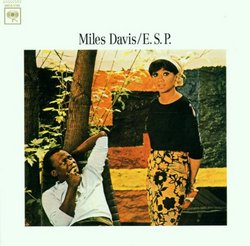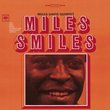| All Artists: Miles Davis Title: Esp Members Wishing: 1 Total Copies: 0 Label: Sony Album Type: Original recording remastered, Import Genre: Jazz Style: Bebop Number of Discs: 1 SwapaCD Credits: 1 |
Search - Miles Davis :: Esp
 | Miles Davis Esp Genre: Jazz
Japanese Master Sound Jazz Series reissue featuring DSD remastering & the original artwork in a limited edition miniature LP sleeve. |
Larger Image |
CD DetailsSynopsis
Album Description Japanese Master Sound Jazz Series reissue featuring DSD remastering & the original artwork in a limited edition miniature LP sleeve. Similar CDs
|
CD ReviewsMiles Finally Gets His Creative Engine Restarted Talking Wall | Queen Creek, AZ | 07/05/2008 (5 out of 5 stars) "First of all, I am passionate about the music of Miles Davis. I own every officially released recording (Savoy, Prestige, Blue Note, Columbia) going back as far back as the Savoy recordings with Charlie Parker all the way up to Star People (his last good release in my opinion). I've read the autobiography and numerous biographies. I'm a semi-professional musician. I KNOW this man's music, intimately. I'm well qualified to spray my opinions about regarding this guy's music. Miles was in something of a rut from the time Coltrane left the party in 1959 until Wayne Shorter finally joined the band in September 1964. Look at the records released during this window of time, they are mostly live performances of his quintet(s) rehashing the same tunes. Oh, those are worth owning for sure as the players change and the interpretations of the tunes vary. But there was no startling change in direction. Miles started to get up off his lazy creative backside in 1963 when he formed 4/5 of this quintet for the Seven Steps to Heaven sessions. The line-up that emerged from those sessions featured the wonderful George Coleman on tenor along with the rest of the gang found on ESP. But still, there were no startling developments in the direction of the music. Subsequent live releases were back to the tried and true tunes (If I Were A Bell, Stella By Starlight, Four, etc). Wayne Shorter finally finished his commitment to Art Blakey in 1964 and joined Miles for an appearance at the Hollywood Bowl without any rehearsals beforehand. Miles had been pursuing Shorter since Trane had started making rumblings he was going to strike out on his own back in 1958. In fact, Coltrane once called Shorter and asked him if he'd take his place so that Miles would leave him alone and let him get on with his own music. Wayne called Miles and told him he heard the tenor chair was open. Miles told him he didn't know what he was talking about, he had a tenor player. When Wayne finally appeared on the scene, EVERYTHING about the music Miles' band was playing changed. The listener can hear the change even in the earlier Miles in Berlin concert even though the set is basically that same handful of tunes Miles had been milking for the past six years. The music on ESP is fresh, different. It's being fueled by young creative minds of Williams, Shorter, Hancock, and Carter but the vehicle is driven by Miles - he sets the course. The change in the music is thorough, yet somehow it isn't jarring at all. It's a natural transition into an order that "should be". Very unlike the transition that Coltrane made in '65. That transition requires patience and a leap of faith from the listener (which, once made is very rewarding). ESP is like a sunny day after a week of rain. It is Spring after an especially cold Winter. The sound is distinctly Miles because no one, and I mean NO ONE has as personal a sound on a chosen instrument as does Miles Davis. The secret of this line-up is the real strength in the musical relationships of the players - they know each other's tendencies and they anticipate and play off one another brilliantly. It's as if all the right stars in the heavens have finally aligned properly for the birth of this music. Shorter and Hancock show they are not only great players but can compose interesting music rich in harmonic and rhythmic possibilities. Tony Williams comes into his own and plays those drums in a way that drums have never before been played. He's explosive like Philly Joe and yet, the rhythms are like vectors going in eight different directions at once, a sort of rhythmic octopus if you will. Different, moving in different directions and yet unified at the core. I'm a huge fan of the classic Coltrane quartet as well but this band, as far as ensembles go and the ability of the musicians to work together yet maintain individuals voices, is a cut above even that wonderful group. I'll just come right out and write it. I hate using phrases such as "greatest this..." and "greatest that..." I'll make an exception here. This is the greatest small jazz ensemble of all time - yes, yes, yes. As a working unit they even surpass the sextet with Adderly, Trane and Evans - Blasphemy you say! LISTEN: I'm not saying they are better musicians. I'm saying this is the tightest and yet free-est of all Davis's bands and that as a unit, they are a cut above anything anyone else had done before or since this group. I'm not going to write details about every single tune on this release, others have done that and besides, the music can only speak for itself. I WILL tell you that every single release this line-up made from ESP through Filles de Kilamanjaro is essential listening - if you like Miles Davis or even THINK you like Miles Davis, you must own these releases (see tags below). If you have limited exposure to the music of Miles Davis but have Kind of Blue (doesn't everyone own that recording?) then I think you will like this music. It isn't Kind of Blue. It isn't the monumental, paradigm shattering work that was Kind of Blue. But in terms of ambience and mood, I think that if you like that record, you will like this one too. It is Miles after all." The first studio recording with the Second Great Quintet sho Christopher Culver | 07/19/2009 (5 out of 5 stars) "When Miles Davis assembled his second great quintet his music could depend on strong instrumental skills. Obviously saxophonist Wayne Shorter, pianist Herbie Hancock, bassist Ron Carter and drummer Tony Williams have gone down in jazz history as some of the greatest performers of their respective instruments. But as the quintet's 1965 debut album E.S.P. shows, this troupe proved compositionally reinvigorating as well. E.S.P. is for me where Miles Davis starts producing consistently great music, as the post-bop compositions contributed by his band members is supremely refined and elegant jazz. There's also a little bit of clowning around, such as towards the end of "R.J." and Miles' entrance with a Harmon mute in "Agitation", which gives a human face to the diamond-faceted songwriting. While later Miles Davis albums transitioned to a smooth stream of music where multiple people are soloing at the same time, E.S.P. has the most clearly delineated solos of the Second Great Quintet era, which gives listeners to hear the particular skills of each member in isolation. Tony William's long drum solo which opens "Agitation" is perhaps the high point of the album. Shorter's opening on the title track is one of the most assured performances of his career. And while Miles himself was never much of a virtuoso, he does seemed pushed by his new bandmates to give his very best efforts. His solo on the title track, picking up from Shorter, is one of the most blisteringly fast and complex of his career. While I wouldn't necessary recommend E.S.P. as an introduction to Miles Davis, as post-bop is an acquired taste, but this album is the start of an extraordinary era in his career." Typical Miles K. Satterthwaite | Philadelphia | 07/04/2010 (3 out of 5 stars) "This Cd is Miles coming into the fusion era. I am from the old school of bee bop and it was just OK to me. It seems the music that I like is from musicians that are too old to play or are dead."
|

 Track Listings (7) - Disc #1
Track Listings (7) - Disc #1